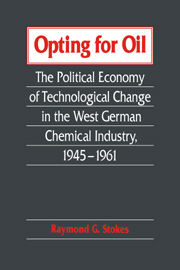Book contents
- Frontmatter
- Contents
- Preface
- Introduction
- Part I Background
- Part II Bargaining from strength: the political economy of technological change, 1949–1955
- Part III Alternative paths to plenty: case studies from the mid–1950s
- 5 Fifty-fifty with the petroleum multinationals: BASF, Shell, and Rheinische Olefinwerke
- 6 Fifty-fifty with the petroleum multinationals: Bayer, British Petroleum, and Erdölchemie
- 7 Going it alone: Hoechst
- 8 State's interest and technological change: Hüls and cold-rubber technology
- 9 End game strategies: the German coal industry and the Fischer-Tropsch process
- Part IV Consolidating the new regime, 1957–1961
- Index
5 - Fifty-fifty with the petroleum multinationals: BASF, Shell, and Rheinische Olefinwerke
Published online by Cambridge University Press: 19 October 2009
- Frontmatter
- Contents
- Preface
- Introduction
- Part I Background
- Part II Bargaining from strength: the political economy of technological change, 1949–1955
- Part III Alternative paths to plenty: case studies from the mid–1950s
- 5 Fifty-fifty with the petroleum multinationals: BASF, Shell, and Rheinische Olefinwerke
- 6 Fifty-fifty with the petroleum multinationals: Bayer, British Petroleum, and Erdölchemie
- 7 Going it alone: Hoechst
- 8 State's interest and technological change: Hüls and cold-rubber technology
- 9 End game strategies: the German coal industry and the Fischer-Tropsch process
- Part IV Consolidating the new regime, 1957–1961
- Index
Summary
Badische Anilin- und Soda-Fabrik (BASF) has had a long and distinguished history in the international organic chemical industry. The first to produce synthetic indigo dye from coal tar, BASF also pioneered in the area of high-pressure chemistry during the first decades of this century. It was thus no accident that when I.G. Farben was formed in late 1925, the new chemical giant was the legal successor to BASF. BASF's ongoing importance in the new firm extended beyond mere legal formality: The chairman of its managing board, Carl Bosch, became the first chairman of the managing board of the I.G. That meant, among other things, that I.G. Farben would emphasize some of the same high-pressure synthesis technologies that BASF had stressed in its research and production programs.
Despite its tradition of excellence and leadership in new developments in organic chemical technology, there were some reasons that one might have expected BASF to hesitate about moving into petrochemical technology in the immediate postwar period. For one thing, BASF, alone among the major successors to I.G. Farben, had, by the spring of 1953, achieved clear title to its own coal mine: the Gewerkschaft Auguste Victoria. Assured of its raw-materials supply, BASF might have been expected to be less interested than others in developing technologies that would involve surrendering direct control over its source of raw materials and energy. Furthermore, BASF had at its disposal what appeared to be a promising new set of technologies in Reppe chemistry.
- Type
- Chapter
- Information
- Opting for OilThe Political Economy of Technological Change in the West German Industry, 1945–1961, pp. 133 - 153Publisher: Cambridge University PressPrint publication year: 1994



